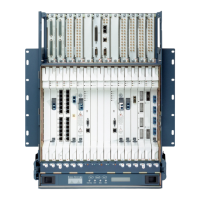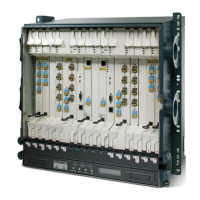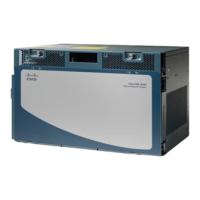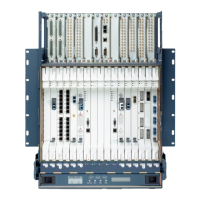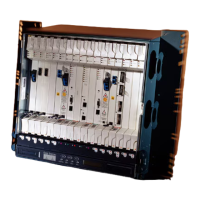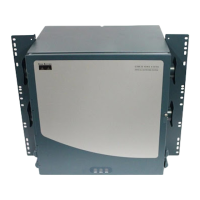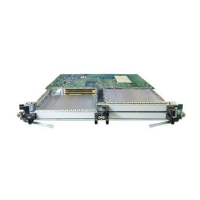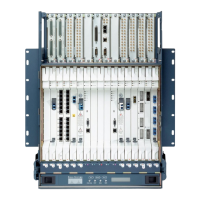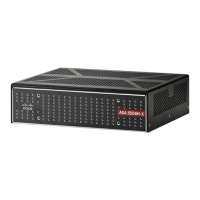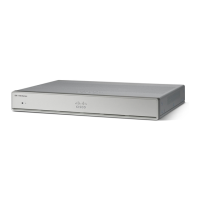2-71
Cisco ONS 15454 Troubleshooting Guide, R8.5
November 2009
Chapter 2 Alarm Troubleshooting
2.7.67 CONTBUS-IO-B
Step 6 If the reset card has not rebooted successfully, or the alarm has not cleared, call Cisco TAC
1 800 553-2447. If the Cisco TAC technician tells you to reseat the card, complete the “Remove and
Reinsert (Reseat) the Standby TCC2/TCC2P Card” procedure on page 2-272. If the Cisco TAC
technician tells you to remove the card and reinstall a new one, follow the “Physically Replace a Traffic
Card” procedure on page 2-273.
2.7.67 CONTBUS-IO-B
Default Severity: Minor (MN), Non-Service-Affecting (NSA)
SONET Logical Object: EQPT
A TCC B to Shelf Communication Failure alarm occurs when the active Slot 11 TCC2/TCC2P (TCC B)
has lost communication with another card in the shelf. The other card is identified by the Object column
in the CTC alarm window.
The CONTBUS-IO-B alarm could appear briefly when the ONS 15454 switches to the protect
TCC2/TCC2P. In the case of a TCC2/TCC2P protection switch, the alarm clears after the other cards
establish communication with the newly active TCC2/TCC2P. If the alarm persists, the problem lies with
the physical path of communication from the TCC2/TCC2P to the reporting card. The physical path of
communication includes the TCC2/TCC2P, the other card, and the backplane.
Clear the CONTBUS-IO-B Alarm
Step 1 Ensure that the reporting card is physically present in the shelf. Record the card type. Click the
Inventory tab and view the Eqpt Type column to reveal the provisioned type.
If the actual card type and the provisioned card type do not match, see the “MEA (EQPT)” alarm on
page 2-182 for the reporting card.
Step 2 If the alarm object is any single card slot other than the standby Slot 7 TCC2/TCC2P, perform a CTC
reset of the object card. Complete the “Reset a Traffic Card in CTC” procedure on page 2-270. For the
LED behavior, see the “2.8.2 Typical Traffic Card LED Activity During Reset” section on page 2-260.
Step 3 If the alarm object is the standby Slot 7 TCC2/TCC2P, complete the “Reset a Traffic Card in CTC”
procedure on page 2-270 for it. The procedure is similar.
Wait ten minutes to verify that the card you reset completely reboots and becomes the standby card. (A
reset standby card remains standby.)
Step 4 If CONTBUS-IO-B is raised on several cards at the same time, complete the “Reset an Active
TCC2/TCC2P Card and Activate the Standby Card” procedure on page 2-270.
Wait ten minutes to verify that the card you reset completely reboots and becomes the standby card.
Step 5 Verify that the reset is complete and error-free and that no new related alarms appear in CTC. A green
ACT/SBY LED indicates an active card. An amber ACT/SBY LED indicates a standby card.
Step 6 If the CTC reset does not clear the alarm, complete the “Remove and Reinsert (Reseat) Any Card”
procedure on page 2-273 for the reporting card.
Step 7 If the reset card has not rebooted successfully, or the alarm has not cleared, call Cisco TAC
1 800 553-2447. If the Cisco TAC technician tells you to reseat the card, complete the “Remove and
Reinsert (Reseat) the Standby TCC2/TCC2P Card” procedure on page 2-272. If the Cisco TAC
technician tells you to remove the card and reinstall a new one, follow the “Physically Replace a Traffic
Card” procedure on page 2-273.
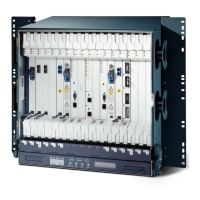
